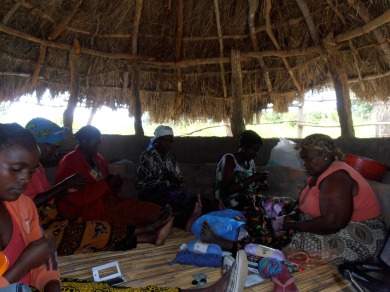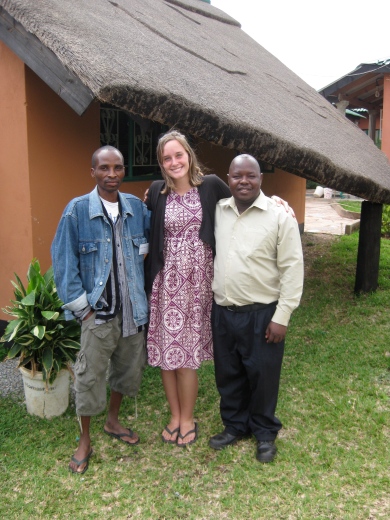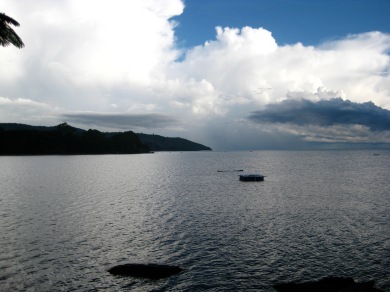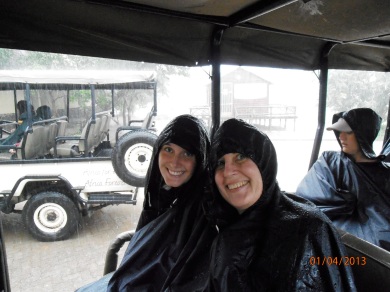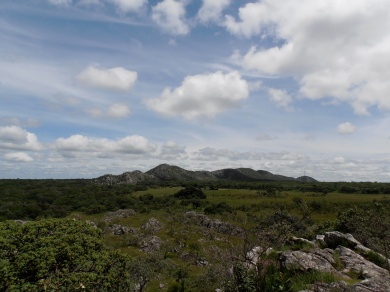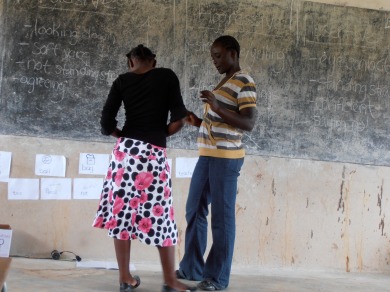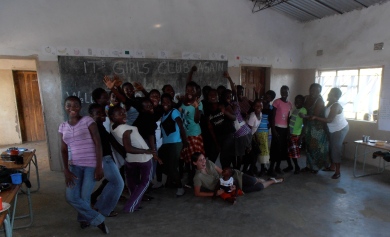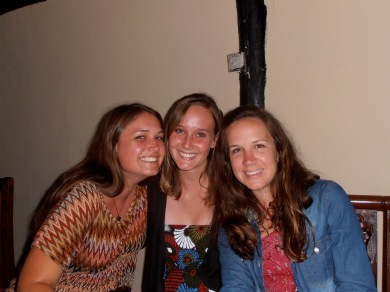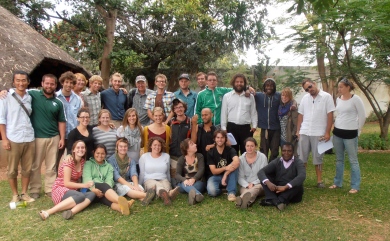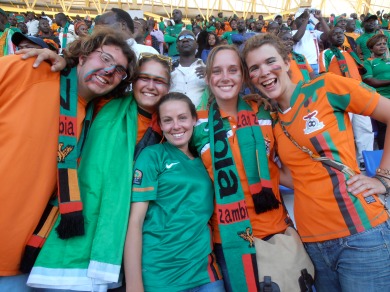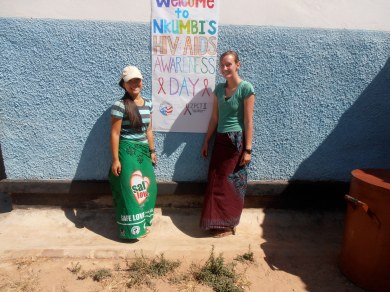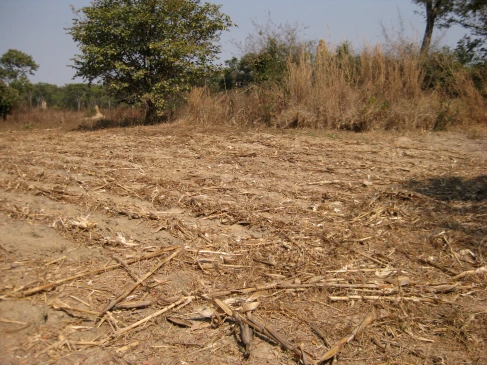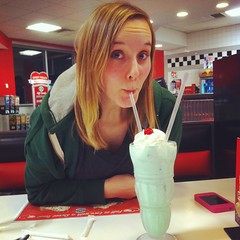Well it has been awhile since my last blog post, and I apologize but life has been crazy here! I guess I have to go all the way to September….
Since I had just come back from IST (week long training in August) I was really motivated again to start projects in Chankomo. So I met with my counterpart, Charles, and we made a plan of visiting each of the villages in my catchment to introduce myself and my job, talk about the deforestation, and sustainable development. I was extremely impressed with Charles! He took over all the discussions and helped the villagers understand. I also started planning with different groups for building tree nurseries in October. September also was when the first group of volunteers that I met in country were leaving, their service being complete. It made it even more real how fast my time here is going!
With September being all about working in the village, October was a good balance of working in the village and vacation. It started with doing a couple Msangu tree nurseries with my women’s group and then a couple different individuals. It was a process because first we had to build the stand to keep the tree nurseries off the ground. This is important because in the village you have chickens, cows and goats that can come and eat the seedlings, or the worse thing about Zambia…the termites. They seem to go after everything and anything! Once the stand was built we gathered old manure, sand and forest soil for the pots. These we mixed in a 1:1:3 ratio to enhance root growth and give nutrients to the seedlings. Next we packed the pots and prepped the seeds by clipping the outer shell. Once all the seeds were packed we planted the seeds and put them up on the stand. With the tree nurseries I also incorporated using different things around the village for pots, incase the plastic ones were unavailable. In total we planted over 1000 Msangu trees that will be ready to plant in the next couple of months! I check on them regularly, and they were doing well for a while until the rains came and two of the stands fell! Some of the trees survived, but we know for next year to build stronger stands.
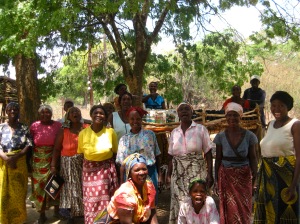
My Women’s group in front of their tree nursery
After three weeks of tree nurseries it was time to head out on vacation! It started with a night at ATB in Mkushi with some amazing people! There was a big group of us there and we had a braai (BBQ in America) with a miner, Nico, and his wife, Marianna. The food was great and it was the perfect way to start off the vacation. The next day we headed up to a white farmer’s place, Pieter’s, for another braai to celebrate Zambian Independence day. Pieter is a white organic farmer who grows the only organic tobacco in Zambia. His place is absolutely beautiful and he was extremely welcoming. The first day we spent swimming in the river on his property. There was a waterfall that we climbed up to and swam under, and then was a couple platforms to jump off of. We spent hours down there and it was so much fun! That night Pieter killed a sheep for us and so we had a very filling and delicious meal. The next morning we woke up and sat around the camp fire and ate pancakes. We were really tired from the day before and it was a little cooler so we sat around for awhile just talking and relaxing, finally we moved on to other activities. Later in the afternoon, Kara, Andrea and I decided we needed to take advantage of the water one more time, so we went down to swim and the sun came out! Everyone else joined us and we again spent the afternoon swimming. And that night Pieter killed a pig for us, so again we had a huge delicious meal!
The next morning we packed into Pieter’s canter and he took us to the Great North Road. From there the group split; some of the group going back to Serejne and some of us going north. My friend Lauren and I were heading to Mpika to go to her site for a night and I was excited because it would be my first time seeing her site! All I can say is that I am very jealous of her site! It is very beautiful, she has a huge house, and great people to work with! The next day we were back to traveling. This day ended up being one of my worst traveling days in Zambia. We were trying to make it to Mbala (one of the most northern towns) in one day, but there were no cars on the road, so we got stuck in Kasama. Luckily, there is another Peace Corps house in Kasama. We stayed the night there, and I was able to see my friend Ijoema who was staying there. And finally the next day we made it to our destination of Mpulungu, or Lake Tanganyika!
I had heard horror stories of everyone I had told I was going to Lake Tanganyika in the hottest month, and so I was a little nervous but it ended up being fun! We were up there to celebrate two of my friends’ birthdays, Drew and Chandra, and even though it was extremely hot the lake was beautiful! We spent the day swimming in a pool lakeside, because the lake is very rocky and crocodiles are prevalent. The next morning we decided to go see Kalambo falls. Kalambo Falls is twice as high as Victoria Falls and is the second highest falls in Africa, so I was excited to go, but little did I know what I was getting myself in to. We started by taking a boat at 5:00am across part of the lake, and I am no sure why I thought this was a good idea because I get extremely seasick. I was fine for the first ten minutes and then it all went downhill from there. For the rest of the ride I was holding on to the edge of the boat trying not to throw up and from what everyone says I was a wonderful shade of green. About an hour later we land at a little village on the edge of a mountain, and without a break start rapidly climbing that mountain. None of us had been there so we didn’t know what to expect, but I believe that hike up was one of the hardest things I have done. I did mention that it was the hottest month of the year, the slope is very steep, and we didn’t bring enough water or food. So I was profusely sweating, still feeling nauseous, and dehydrated.. let’s just say I wanted it to be over with. Two hours later we finally reached it! And no matter how miserable I was getting there it was worth it! We climbed over to the top and reloaded on water (we used iodine tablets) and relaxed for a while. Once, I was rested and re-hydrated I was able to enjoyed the view and the hike back, which took half the time. And once back at the lake we were able to take a nice, cold swim! For the boat ride back I learned my lesson and took some Dramamine one of the other volunteers had with them, so I passed out in the bottom of the boat! That night my friend, Jesse, and I decided that even though we were supposed to stay for a couple more days, we wanted to head back early to rest a couple days at the house in Serenje before going back to site. The next morning we left at 5:30am and made it to Serenje by 3:00pm, much easier than going up! I spent a couple days at the house, and one of those days was Halloween, which we celebrated by dressing up the housekeeper and one of the guards and teaching them about Halloween! The whole vacation was fun, but I was definitely ready to go back to the village!
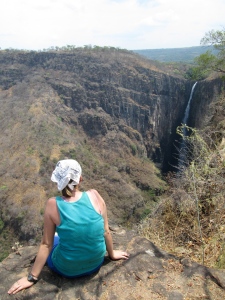
Me at Kalambo Falls
After my vacation I was ready to dive back into projects in my village and for November it would be to push for soya before heading off for meetings. Soya is the name thing as soy in the States, and I was pushing it because it doesn’t use fertilizer, and is more nutritious than maize. The first week in November I had a workshop explaining the benefits of soya and how to plant it. The second week with the help of my friend Trish I had a cooking workshop where I talked about all the things you can make with soya, and I showed how to make soya sausages. It was a big hit, 36 people showed up and 8 of them were men! It went so well that I am planning on having another one where I make soya milk.
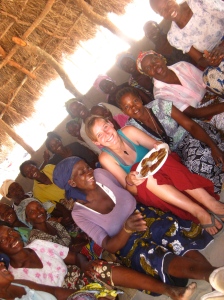
The finished soya sausages and the people who came
The third week in November I had to go to Serenje for the biannual provincial meetings. These meetings are to get everyone in your province together and discuss new rules for Peace Corps and go over the house rules again. There are now 40 of us in Central Province and so the meetings lasted really long and it was very stressful having everyone there. On the other hand it was great seeing a lot of my friends that I don’t normally see on a regular basis.
While at the meetings we also celebrated Thanksgiving! This was my first big holiday away from home, but I didn’t get homesick because I was able to spend it with my new family over here in Zambia! We also had a ton of food like turkey, stuffing, cranberry sauce, mashed potatoes, greenbean casserole, and homemade pumpkin pie!
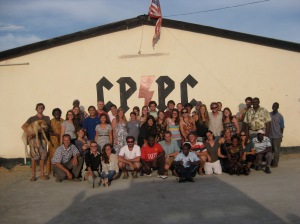
the Central Province family
The next week it was finally time for Camp GLOW! This is a girls camp held all over the world where volunteers bring girls and mentors from their community to teach them about different things they normally wouldn’t learn in the village. GLOW stands for Girls Leading Our World, so the whole basis of the camp was to empower them. And I have to say it was one of my favorite things I have done in Zambia so far!
The camp started on Sunday, November 25th with all of us meeting in Mkushi before we headed to Ndubaluba where it would be help. Once all 20 girls, 10 mentors and 7 volunteers were there we piled into a canter and headed out. Right away I felt like I was back at camp because we started singing songs and dancing, but most of them were in Bemba so us volunteers tried to follow along as much as possible. Once there we had lunch and made tie-dye t-shirts to wear for our group picture. That afternoon we talked to the girls about their “paths to the futures” and what obstacles they would have to face to get there. Then after dinner we played volleyball, which was hilarious! And after volleyball we had a campfire with delicious hot chocolate.
The next morning we talked about different statistics of women in Zambia, and this was quite a shocker to a lot of the girls and mentors. Going off of that we then had the girls write or draw about a person they admired and encouraged them to give it to that person. I was shocked when one of the girls (not even from my village) wrote me a letter about how she admires me. After that we talked about what it means to be assertive and how to say no, and had the girls perform skits. I was extremely impressed with their skits!
After lunch half of us went down to the dam and went canoeing. This was one of my favorite things! Most of the girls had never been in a boat and even fewer knew how to swim! There were 3 of us volunteers there so we split up and took 3 girls each in our boats. I have to say I think my girls understood the idea of paddling together because we were the fastest. However, I do not think they understood that we needed to stay in the middle of the boat because I think I spent a lot of time hurling myself to one side of the boat to keep from tipping. The staff of Ndubaluba had us play a couple games and I think the girls really enjoyed it. When we were safely back on shore we went back into the water to swim a bit. We still had our life jackets on so I helped a couple girls and mentors swim around..mainly just splashing.
That afternoon we talked about the difference between a unhealthy and a healthy relationship is. The volunteers acted out skits, and the girls thought we were hilarious! Then our activity for the night was cultural dancing. Let me just say I think Zambians can move their hips like no one else! The girls and mentors each did a dance and then they tried to get the volunteers to dance but we were nowhere as good as them. It all turned into a big dance party, and I think by the end I could at least begin to move my hips like them!
The next day we started off with peer pressure and then went in to boyfriends and sugar daddies. We helped the girls understand these better by including games and songs to help them remember the important things we talked about. And that afternoon my half of the group stayed behind and made journals and talked about malaria. It wasn’t as exciting as canoeing but it was a much-needed break! That afternoon we talked about puberty and the changes that boys and girls go through. They learn about this in school, but not extensively so it is very important to teach it. Finally that night we talked about periods and then made homemade sanitary pads for the girls to take with them.
The following morning we had a guest speaker from Lusaka come from Youth Alive Zambia. She talked about rape and sexual abuse. It is a tough subject but extremely important for girls that age. At the end everyone left but the girls and they had a chance to feel comfortable asking questions and opening up. After that talk we climbed the rock wall! In my half all the girls climbed and almost all made it to the top! Only two of the mentors wanted to do it and only one made it to the top. After everyone had gone me and my friend Steve were challenged to race to the top barefoot like they did..and I won!
After that it was time for 5 of us to leave so other volunteer would have a chance to spend time with the girls. I was really upset and didn’t want to leave! I feel I had made a connection with the girls and wanted to spend the whole week with them. I did talk to the other volunteers after camp and they said the second half went really well.
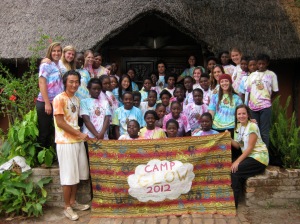
Camp GLOW crew
So that is the past 3 months of my life here in Zambia. It has been very busy and exciting, and I know I still have 16 months left of it! Right now I am in Serenje again for a HIV/AIDS workshop for a week and then I head out on vacation to Malawi for Christmas! After New Years my mom is coming and I cannot wait to see her! Don’t worry I will do a blog post about all my adventures in Malawi and with my mom in January!
I also want to thank Darrel and Nancy Wilkerson, as well as my Aunt Sue and Denice Muse for their contributions to Camp GLOW! Without you we couldn’t have done it! Thank you!
